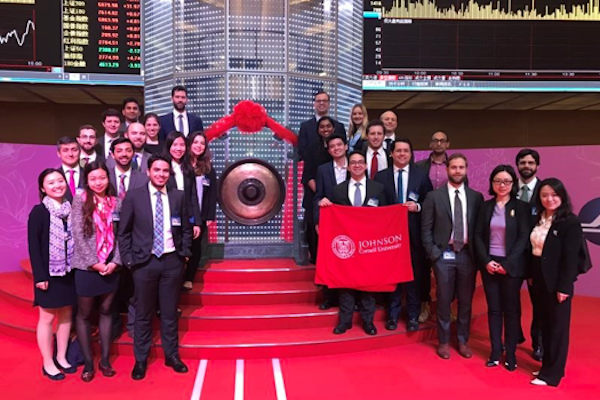Innovation in China: A sneak peek at the future

German Peralta, MBA ’17, and classmates visited the Shanghai Stock Exchange in China when he was a student in 2015.
As I reflect on my experience in China almost three years ago, I am amazed as how closely Latin America is following in China’s footsteps. With venture capital and private equity investments flowing into the region, the innovations I noticed in China back in 2015 are starting to be seen in countries like Brazil, Mexico, and Colombia. Latin America holds roughly 10 percent of the world´s population and about 8 percent of the world’s economy, however less than 2 percent of the private equity investments go into the region.
In 2015, I participated in a study trip to China, thanks to the Cunningham Fund, part of the Emerging Markets Institute at the Samuel Curtis Johnson Graduate School of Management. This trip allowed me and my classmates to visit a soon-to-be non-emerging market and to understand the cultural and business nature of the Chinese economic boom. We visited companies in Beijing, Hangzhou, and Shanghai, enjoyed local food, and got to meet alumni from our school.
This eye-opening experience allowed me to understand how the scale of China and its increased middle-class will enable the most populous country in the world to become the largest economy in the world by 2030, according to World Bank projections. Chinese companies focus on monetizing customers, while the growing public and private equity market enables funding that will allow its sustainable growth. We visited private companies with accelerated growth as well as China´s biggest private equity fund and the Shanghai stock exchange. These experiences and the visit to cultural sights added value to the trip and allowed me to understand China and to have an idea of what to expect in the coming years, particularly in emerging economies such as those of Latin America.
Learning about the power of Chinese entrepreneurship
We visited three companies during the trip: VIP Kid in Beijing, Alibaba Group in Hangzhou, and Ctrip in Shanghai. These companies have the same common revenue driver: the disposable income of the increased middle class.
VIP Kid is a tech company that has created a business out of teaching English to children in China using certified teachers who work from home in the United States. The company quadrupled in size in just one year and generated revenues in excess of ¥120 million (~$40 million). Offering a $50-an-hour service (more than half of the Chinese minimum wage), the company takes advantage of a language gap in the market and an increased disposable income for upper middle-class families in China.
Alibaba is now one of the largest tech corporations in the world, having managed to merge the Chinese equivalent of Amazon, eBay, WhatsApp, Venmo, Tinder, Uber, and Apple Pay into one. In their Silicon-Valley-like campus in Hangzhou, we talked to employees and discovered that the size of the country´s growth has enabled Alibaba to create incentives for employees to innovate within the company instead of venturing outside it to start separate businesses. This allows employees to get massive funding, and the strong equity compensation enables them to have ownership as well.
Finally, Ctrip—the Chinese $20 billion Expedia-like travel agency—has managed to take advantage of the growing travel industry in China and the fact that English is very uncommon there. The company operates as a one-stop shop for Chinese travelers visiting everything from domestic destinations to Machu Picchu in South America. In its massive Shanghai business complex, Ctrip’s offices seem like those of a SoHo startup that will certainly overtake its American rivals soon.
The merits of Chinese equity funding and the Shanghai stock exchange
To learn about equity funding, our group visited JD Capital in Beijing and the Chinese stock exchange in Shanghai. At JD Capital, we discovered that fundraising is very easy in China and that JD’s cultural and language advantage over large, global American or European competitors allows them to invest in mid-market companies that are thriving within the economic boom. Over the past years, they´ve managed to average a 30-percent internal rate of return with an average holding period of six years. This is achieved with zero leverage given the debt restrictions imposed by the Chinese government. Major exits are through the public markets, while the still-small stock exchange in China allows multiple expansion at astronomically high earnings before interest, taxes, depreciation and amortization multiples. Investors are dying to invest. However, JD carefully picks its deals given that the still-controlled initial public offering (IPO) dynamics may take well over a year.
We also visited the Shanghai stock exchange, where we learned that the IPO process is long—currently over 60 companies waiting to get listed—and government officials face pressure to expedite the approval process. Even if we consider the current time to IPO, the Shanghai stock market should double in size in a year.
In addition, over 90 percent of the investors on the stock exchange are local Chinese who are starting to invest their savings in the public markets. This is an indicator that, with the expansion of the middle class in China, public markets should continue to grow and that growth will come back to the general public through returns. This resembles the boom in the stock market in the United States in the 1990s.
China offers a model for other emerging markets
In summary, China is taking advantage of the accelerated growth of its economy. Contrary to other emerging markets, China has managed to disburse growth to large pools of its previously impoverished population which now have increased disposable income. The country’s spotless modern cities and massive luxury malls show that China is currently growing and will continue to grow given its conditions. The question is, can similar economies like Brazil or Russia learn to accelerate their own internal growth by looking at China? The only difference between China and other large, emerging economies is that China grew its economy initially with little foreign investment, while the rest of the world will most likely have a head start given the excess of capital waiting to be placed by private equity and sovereign wealth funds.
Opinions in this article are the author’s and do not necessarily reflect those of Cornell, Johnson, or the Emerging Markets Institute.

